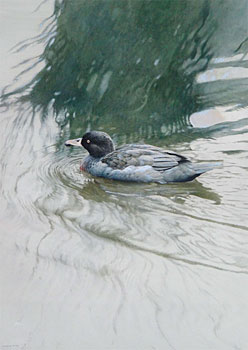New Zealand Blue Duck
72.5 x 52.1 cm
est. $15,000 - 20,000
Provenance: Purchased from International Art Centre 1980
Private Collection, Queensland
Private Collection, Northland
Exhibited: Raymond Ching Paintings & Drawings, International Art Centre 1980
Illustrated: p. 98 New Zealand Birds, An Artist's Field Studies Raymond Ching and Grahame Turbott QSO, Reed Methuen Publishers Ltd 1986
The plumage of the Blue Duck is a dullish, slate blue colour and along with the curiously toned, reddish brown patterning occurring on the breast, provides an excellent example of protective colouration. When an intruder approaches the rushing high-country streams where this duck is found, the birds remain perfectly still, becoming almost impossible to see against the tumble of rocks and rust-coloured lichens that form their secluded river home.
No other New Zealand duck chooses to live in quite this environmental niche, but habitat is not the only feature that makes the Blue Duck unique: there are few indigenous waterfowl in New Zealand, but the Blue Duck is one that can be found nowhere else. It's a specialised species, with definite requirements in the matter of habitat, and apparently quite dependent upon various aquatic animals that flourish in water highly charged with oxygen. In consequence, it is pretty much tied to running, freshwater streams. (The torrent ducks of South America and the harlequin ducks of the Northern Hemisphere are two examples of birds that make use of similar territory, although the latter live on the sea during winter, moving inland to mountain streams to breed.)
When seen at close quarters, the bill of the Blue Duck is particularly distinctive. The large, white mandibles sometimes have a faint, pinkish tinge, and some writers suggest that, depending upon the emotional state of the bird, the bill can "blush" into a definite pink colour on occasion. However, the most remarkable features are the loose, rubbery, black "flaps" at the tip of the upper mandible. These modified lobes hang down over the lower bill and are apparently used to help collect food from underwater rocks, the lobes acting rather like the seal around the bottom of an upright vacuum cleaner. This feeding is carried out in relatively shallow water (there is some debate on their ability as divers), often during the twilight hours.
When disturbed, they prefer to float away downstream rather than take to the air, even though they are strong fliers.
New Zealand Birds, An Artist's Field Studies, Reed Methuen Publishers Ltd 1986





